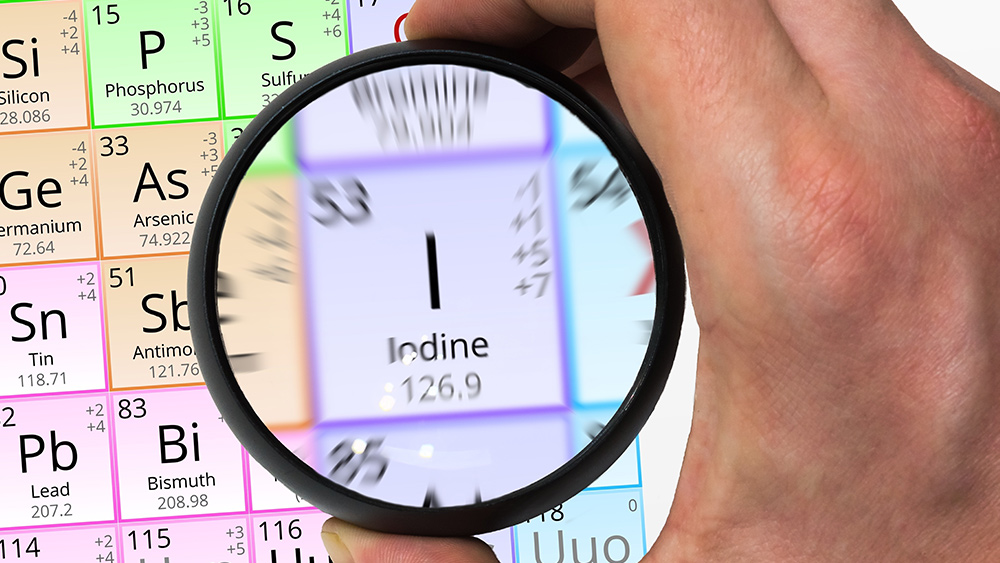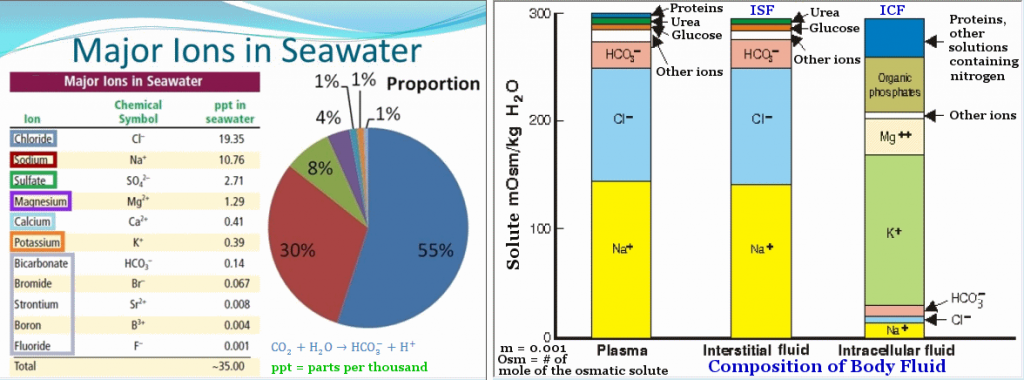
Rectifying Iodine Deficiency.
Taking a supplement of iodine (Lugol’s solution) maintains levels high enough for the iodine to displace the toxins. Some organs need iodide – the ion form of iodine and some require iodine:
Iodide: Thyroid, skin,
Iodine: Breast, ovaries, prostate,
Iodide or Iodine: Kidneys, spleen, liver, blood, salivary glands, intestines
Frenchman Jean Lugol 1829 introduced a 1:2 ratio iodine:iodide solution in distilled water – still today called “Lugol’s solution“. It is on the World Health Organization’s List of Essential Medicines; the most effective and safe medicines needed in a health system.
Personally I would not describe Lugol’s solution as a medicine any more than water is a medicine. Lugol’s is a nutritional supplement with additional alternative direct applications, such as a disinfectant, even for purifying drinking water.
The American version of Lugol’s is not the same strength as the European one. When the European version refers to 15% it means 15% pure iodine plus 30% potassium iodide. The American 15% means 5% iodine plus 10% potassium iodide so there is a huge difference between them.
Dr Brownstein’s benchmark book “Iodine – Why you need it” explains in great depth the appropriate protocols for anyone with a medical condition wishing to use Lugol’s solution.
Personally I just use Lugol’s to maintain good health and preempt any potential deficiencies. In contrast my partner used it to successfully end 14 years of synthetic thyroxine addiction following a diagnosis of Hashimoto’s disease. She has been completely off the drug and free of its horrible side effects now for 6 years and has no thyroid issues.
Exogenous thyroxine shuts the thyroid down generating an addictive dependence on the exogenous supply. If the doctor’s victim tries to stop using it they end up bedridden in only a few days. Weaning yourself off such a devastating drug takes care and patience. Unfortunately Levothyroxine is the most prescribed drug in the U.S. with over 23 million people taking it on prescription (Slightly edging out Crestor – a statin drug).
Thyroid cancer is currently the fastest growing cancer epidemic in the US. We know that iodine deficiency is a direct pathway to many cancers.
Iodine Supplementation (Lugol’s Solution)
In the developed world there is an epidemic of cancer as well as heart disease, diabetes, Alzheimer’s and chronic diseases in general. One in seven women suffers breast cancer and one in three men suffers prostate cancer. Ever increasing exposure to toxic chemicals (including ALL medical drugs) and the concurrent decline in food nutrient levels certainly play a key role in creating this situation. The medical world chooses to remaining totally blind to both issues. Doctors have no education in nutrition (you only have to look at hospital meals to see that!) and in the US each year 80,000 people die from the CORRECT use of pharmaceutical drugs – making it one of the leading 10 causes of death.
Iodine supplementation should be part of a basic preemptive strategy for avoiding becoming part of those statistics. Iodine doesn’t only prevent many problems.
Supplementation of iodine and iodide (Luglo’s solution) detoxify the body from toxic halides. This should ideally only be a small part of a much more extensive nutritional and hygiene program.
Hygiene
Simple hygiene goes a long way towards protecting against iodine deficiency.
- Avoid eating food stored in plastic containers and packaging
- Use a filter at home to remove chlorine from tap water
- Drinking good mineral water helps detoxification
- Try to replace all household and personal care products with chemical free ones
- Ventilate the house at every opportunity
- Avoid soft drinks with bromide or fluoridated water components
- Avoid baked goods with bromine added
- Avoid fluoridated dental products
- Sweating – working out and saunas help detoxification
- Avoid soy, millet and gluten products
- Reduce goitrogenic foods – avoid raw cruciferous vegetables and almonds
Orthoiodosupplementation
Regardless of whether the goal is to deal with an existing problem or to avoid ever having to cross the threshold of a any medical doctor’s clinic, the same basic nutritional approach is appropriate.
First of all the iodine levels need to be increased.
Secondly the mitochondrial function needs to be assisted.
Thirdly antioxidants (and supporting minerals) added to combat runaway oxidation issues.
That covers not only thyroid issues but the most of the entire huge list of potential diseases possible from iodine deficiency.
Some sources claim “excess” iodine is harmful even in small amounts. This completely contradicts Dr Brownstein and Dr Guy Abraham his mentor. There may be very rare exceptions when this is right but I’ll put the issue down to iodophobia for the moment. (Dr Abraham was involved in the most extensive study of iodine ever undertaken – The Iodine Project).
- Iodine
Lugol’s solution – from 12 to 50 mg/day - Mitochondria Function
Vitamin B2 (Riboflavin) 100 mg and B3 (Niacinamide) 500 mg both twice per day - Hormone Synthesis and Activation
Vitamin B1 (Thiamine) 100mg (critical for many of the steps leading to the synthesis and activation of thyroid hormone and its thyroglobulin protein) - Antioxidants
Vitamin C between 3 and 10 grams per day – dosing to suit intestinal tolerance.
Magnesium 200 mg (prevents excess calcium from allowing excess oxidation, is essential for the production of glutathion and for improving its function)
Selenium 100-200μg/day (needed for glutathion – the master antioxidant and for activating and deactivating thyroid hormones)
Manganese 10 mg (Manganese superoxide dismutase (MnSOD) is the principal antioxidant in mitochondria.)
Iodine itself is a potent antioxidant – more potent than vitamins C and E.
Harvested “Unrefined” Sea Salt is not a source of balanced minerals
Dr Brownstein also recommends unrefined sea salt for supplying the minerals such as iodine and perhaps magnesium. However I believe this to be an error. The problem is that there is no such thing as unrefined salt on the market which by law must be 97% or more pure sodium chloride (solids).
Magnesium, potassium, calcium and sulphates are all skimmed off in the evaporation process when sea salt is harvested. I use food grade Epsom Salts to provide both magnesium and sulphates.
Some sea salts clarify that they are 14% water and Dr Brownstein considers this brine to contain minerals but it’s only a very small amount by weight.
I verified the popular Himalayan mine certificates for their salt content and found it to be 99% NaCl.
Seawater (especially water samples dated near 4 billion years old), unlike harvested sea salt and mined salts, has a very close mineral composition to plasma and interstitial fluids (“internal sea” which bathes all cells) in the body. (Unicellular organisms require at least 10% humidity to function and survive!)
Fluid composition inside the cell (Intracellular Fluid) is quite different from sea water as the constituents are altered by the metabolic process of life.

Iodine Allergy ???
Many people find that they can have an allergic reaction when administered iodine in hospital or when purchased from a pharmacy. Skin can blister or they can even have an anaphylactic reaction.
Iodine is essential for life, being in every one of your body’s cells – so how is this possible?
Hospitals and pharmacies use a modified iodine compound.
Povidone-Iodine is the name of the active substance in the dark brown liquid and is commonly called by the trade name “Betadine”.
Betadine 10% solution contains 10% Povidone-Iodine giving 1% iodine. Inactive ingredients are purified water and sodium hydroxide.
It’s the povidone that people are allergic to not the iodine.
The chemical formula for Povidone-Iodide is: (C6H9NO)n
Other names used are:
Polyvinylpyrrolidone
1-ethenylpyrrolidin-2-one
PVP, Povidone, PVPP, Crospovidone, Polyvidone, PNVP
Poly[1-(2-oxo-1-pyrrolidinyl)ethylen]
1-Ethenyl-2-pyrrolidon homopolymer
1-Vinyl-2-pyrrolidinon-Polymere
Food additive E1201
Povidone-Iodide (PVP-I) was discovered in 1955 at the Industrial Toxicology Laboratories in Philadelphia. Since 1811 Iodine has been used as a broad-spectrum bactericide and is also effective against yeasts, molds, fungi, viruses, and protozoans. Due to irritation at the site of application, (apparent) toxicity ??? and the staining of surrounding tissues PVP-I was introduced supposedly to overcome those issues and provide a low dose of iodine.
The main other uses for the unnatural chemical Povidone, other than getting it into your body are as follows:
- as an adhesive in glue stick and hot-melt adhesives
- as a special additive for batteries, ceramics, fiberglass, inks, and inkjet paper, and in the chemical-mechanical planarization process
- as an emulsifier and disintegrant for solution polymerization
- to increase resolution in photoresists for cathode ray tubes (CRT)
- in aqueous metal quenching
- for production of membranes, such as dialysis and water purification filters
- as a binder and complexation agent in agricultural applications such as crop protection, seed treatment and coating
- as a thickening agent in tooth whitening gels
- as an aid for increasing the solubility of drugs in liquid and semi-liquid dosage forms (syrups, soft gelatine capsules) and as an inhibitor of recrystallisation
- as a surfactant, reducing agent, shape controlling agent and dispersant in nanoparticle synthesis and their self-assembly
- as a stabilizing agent in all inorganic solar cells[

I think it will be interesting to see who comments on your articles; will any nutitionists or scientists respond either agreeing or disagreeing? Will you get lots of followers who read and accept what you conclude? I for one see the effects on you and Christiane so I know it works. I don’t use every supplement that you recommend but I do use many of them. So thanks for your intensive research and sharing your findings.
Thanks for the first comment on the new blog! Authoring the blog is already an incredibly useful exercise in itself. Writing not only helps to organise and preserve learned information but it helps original ideas and insights to be emerge and be developed – it’s literally a way of “thinking”. It also exposes sometimes huge unperceived holes in understanding and demands extensive research in unexpected directions. I was a physics and maths person – dumping the sciences that needed ludicrous memorisation when I was only 16 – hence biology was the first to go. Perhaps it’s appropriate then that I find it fascinating for the right reasons now – not to pass stupid exams!